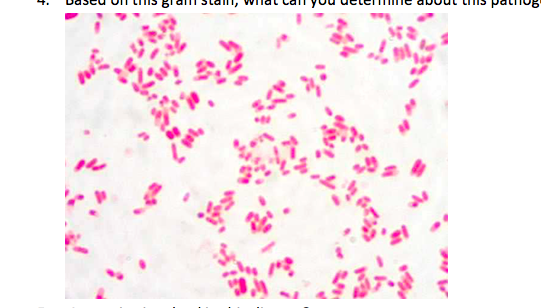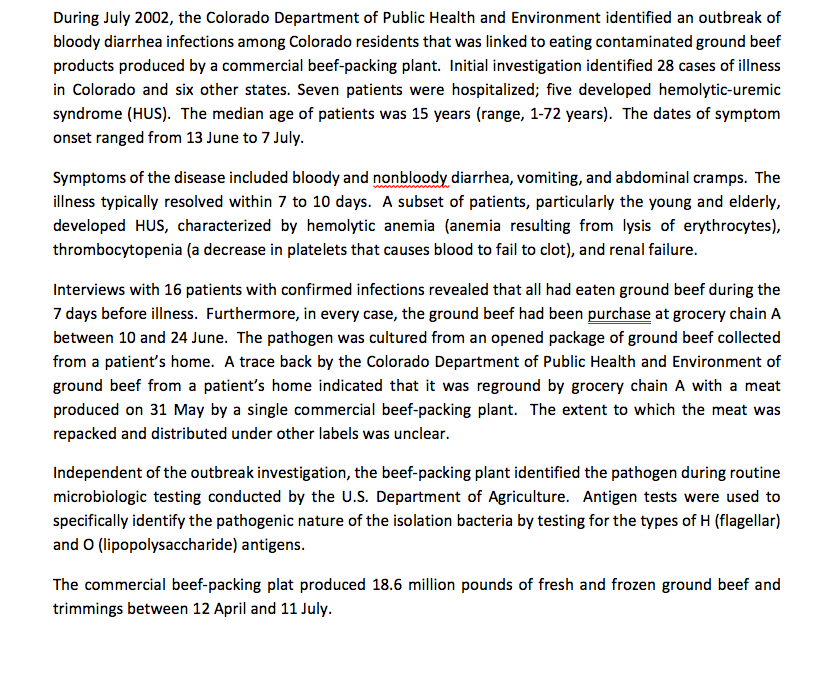What is the most likely pathogen that is the cause of this outbreak? Enterohemorrgaigic E.coli enteropathogenic E.coli Hepatitis A Campylobacter true or false? antibiotics are contraindicated for this disease because it increases the risks of complications. unpasteurized milk is another source of this pathogen. Toxins are not involved in this disease. based on the gram stain, what can you determine about the pathogen? Gram positive cocci Gram negative cocci Gram positive bacillus Gram negative bacillus
What is the most likely pathogen that is the cause of this outbreak? Enterohemorrgaigic E.coli enteropathogenic E.coli Hepatitis A Campylobacter true or false? antibiotics are contraindicated for this disease because it increases the risks of complications. unpasteurized milk is another source of this pathogen. Toxins are not involved in this disease. based on the gram stain, what can you determine about the pathogen? Gram positive cocci Gram negative cocci Gram positive bacillus Gram negative bacillus
Chapter2: Safety In Phlebotomy
Section: Chapter Questions
Problem 2.1E
Related questions
Question
What is the most likely pathogen that is the cause of this outbreak?
Enterohemorrgaigic E.coli
enteropathogenic E.coli
Hepatitis A
Campylobacter
true or false?
antibiotics are contraindicated for this disease because it increases the risks of complications.
unpasteurized milk is another source of this pathogen.
Toxins are not involved in this disease.
based on the
Gram positive cocci
Gram negative cocci
Gram positive bacillus
Gram negative bacillus

Transcribed Image Text:patnog

Transcribed Image Text:During July 2002, the Colorado Department of Public Health and Environment identified an outbreak of
bloody diarrhea infections among Colorado residents that was linked to eating contaminated ground beef
products produced by a commercial beef-packing plant. Initial investigation identified 28 cases of illness
in Colorado and six other states. Seven patients were hospitalized; five developed hemolytic-uremic
syndrome (HUS). The median age of patients was 15 years (range, 1-72 years). The dates of symptom
onset ranged from 13 June to 7 July.
Symptoms of the disease included bloody and nonbloody diarrhea, vomiting, and abdominal cramps. The
illness typically resolved within 7 to 10 days. A subset of patients, particularly the young and elderly,
developed HUS, characterized by hemolytic anemia (anemia resulting from lysis of erythrocytes),
thrombocytopenia (a decrease in platelets that causes blood to fail to clot), and renal failure.
Interviews with 16 patients with confirmed infections revealed that all had eaten ground beef during the
7 days before illness. Furthermore, in every case, the ground beef had been purchase at grocery chain A
between 10 and 24 June. The pathogen was cultured from an opened package of ground beef collected
from a patient's home. A trace back by the Colorado Department of Public Health and Environment of
ground beef from a patient's home indicated that it was reground by grocery chain A with a meat
produced on 31 May by a single commercial beef-packing plant. The extent to which the meat was
repacked and distributed under other labels was unclear.
Independent of the outbreak investigation, the beef-packing plant identified the pathogen during routine
microbiologic testing conducted by the U.S. Department of Agriculture. Antigen tests were used to
specifically identify the pathogenic nature of the isolation bacteria by testing for the types of H (flagellar)
and O (lipopolysaccharide) antigens.
The commercial beef-packing plat produced 18.6 million pounds of fresh and frozen ground beef and
trimmings between 12 April and 11 July.
Expert Solution
This question has been solved!
Explore an expertly crafted, step-by-step solution for a thorough understanding of key concepts.
Step by step
Solved in 3 steps

Knowledge Booster
Learn more about
Need a deep-dive on the concept behind this application? Look no further. Learn more about this topic, biology and related others by exploring similar questions and additional content below.Recommended textbooks for you



Microbiology for Surgical Technologists (MindTap …
Biology
ISBN:
9781111306663
Author:
Margaret Rodriguez, Paul Price
Publisher:
Cengage Learning



Microbiology for Surgical Technologists (MindTap …
Biology
ISBN:
9781111306663
Author:
Margaret Rodriguez, Paul Price
Publisher:
Cengage Learning

Comprehensive Medical Assisting: Administrative a…
Nursing
ISBN:
9781305964792
Author:
Wilburta Q. Lindh, Carol D. Tamparo, Barbara M. Dahl, Julie Morris, Cindy Correa
Publisher:
Cengage Learning

Case Studies In Health Information Management
Biology
ISBN:
9781337676908
Author:
SCHNERING
Publisher:
Cengage
